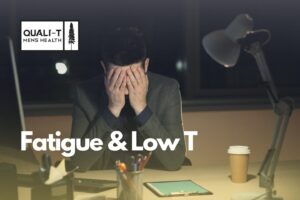
When it comes to evaluating testosterone levels, many providers only focus on total testosterone, but that doesn’t tell the full story. In fact, it doesn’t even tell the most important part of the story! Understanding the difference between free testosterone and total testosterone is crucial for determining if you truly have low testosterone (Low T) and if Testosterone Replacement Therapy (TRT) is right for you.
That’s where Quali-T Men’s Health in Eugene and Salem, Oregon comes in. We help men optimize their free testosterone levels for peak performance and overall well-being.
What is Total Testosterone?
Total testosterone refers to the sum of all testosterone in your bloodstream, including:
- Free testosterone – the active form of testosterone that is available for use by the body
- Bound testosterone, which is attached to proteins like Sex Hormone-Binding Globulin (SHBG) and albumin
Most of the testosterone in your body is bound, meaning it is not readily available for immediate use. Only a small percentage (2-4%) of your total testosterone is in its free, bioavailable form.
What is Free Testosterone?
Free testosterone is the unbound, active form of testosterone that your body can actually use. Since it is not attached to SHBG or albumin, free testosterone is responsible for:
- Energy levels
- Muscle growth and fat metabolism
- Sex drive and erectile function
- Cognitive function and mood stability
While total testosterone gives a broad overview, free testosterone is the most important marker for assessing symptoms of Low T. Think of testosterone like a puzzle piece. It needs to fit into a specific spot, or receptor, to work. If something is bound to it, like SHBG or albumin, it can no longer go into that receptor. So, what’s left over is your free testosterone. This is what you can actually use and why it is so important to check free testosterone. This is your missing puzzle piece.
Why Do Free and Total Testosterone Levels Matter?
Some men may have “normal” total testosterone levels but still experience symptoms of low testosterone due to low free testosterone. This happens when SHBG is elevated, preventing testosterone from being available for use.
Common symptoms of low free testosterone Include:
- Low energy or fatigue
- Decreased libido and erectile dysfunction
- Loss of muscle mass and increased body fat
- Mood swings, depression, or brain fog
- Poor recovery from workouts
How To Decrease SHBG and Increase Free Testosterone
To decrease SHBG and increase free testosterone, it’s essential to look at both the lifestyle and nutritional strategies as well as the hormone therapies that are available. Reducing excess sugar intake, managing stress levels, and incorporating strength training exercises can significantly impact SHBG levels. It is not advisable to try to change SHBG levels with medications. This will cause issues down the line.
Ensuring adequate intake of key nutrients like vitamin D, zinc, and magnesium also play a role in supporting healthy hormone production and regulation. When lifestyle and nutrition changes are not enough by themselves, testosterone replacement therapy (TRT), under the guidance of a qualified provider, plays a vital role.
The goal for those with elevated SHBG levels is simply to raise your total testosterone enough so that there is adequate free testosterone available for your body to use. Yes, this may mean that your total testosterone is above the “normal” range – and that’s okay!
Where Can I Take A Testosterone Test Near Me?
If you have symptoms of Low T, it’s essential to measure both free and total testosterone to get an accurate diagnosis. Quali-T Men’s Health has offices located in both Salem, Oregon and Eugene, Oregon. We offer comprehensive testing to fully assess your hormone levels and develop customized TRT solutions tailored to your unique needs.
Our approach includes:
- Comprehensive lab testing that includes assessing both free and total testosterone
- Personalized treatment plans to optimize the testosterone levels specific to your body
- Ongoing monitoring to ensure your continued optimal health and well-being
If you’re experiencing symptoms of Low T, don’t rely solely on total testosterone levels. Understanding your free testosterone is key to determining whether TRT is right for you.
At Quali-T Men’s Health in Eugene and Salem, Oregon, we take a science-backed, individualized approach to testosterone optimization. If you have any questions about this process give us a call. We’re here to fill in the blanks so that you have a complete understanding.
Schedule a consultation today to take control of your health and performance!





